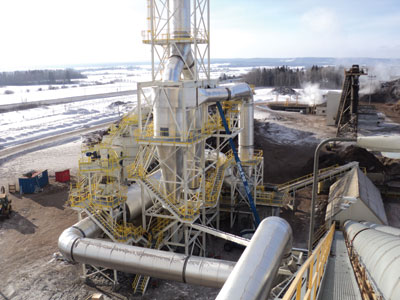
Saint-Félicien Cogeneration
April 1, 2011
By
Colleen Cross
This pre-drying process will increase the heat value of the fuel and require less fuel to run the plant at peak capacity, ensuring top performance during winter conditions.
This pre-drying process will increase the heat value of the fuel and require less fuel to run the plant at peak capacity, ensuring top performance during winter conditions.
 |
|
| The connection ductwork brings hot air from the boiler’s exhaust stack to the dryer, allowing it to pre-dry wet biomass fuel for the boiler. Photo: Büttner |
A subsidiary of Enel Green Power, Saint-Félicien is a 24-MW wood waste fired cogeneration facility. It produces steam and electricity from biomass via a Mitsubishi 10-stage, Alstom generator and provides for the clean disposal of sawmill wood waste.
Marc Poirier, its director, says that in 2009, the company couldn’t achieve the right ratio of fresh and previously buried bark and was forced to stop the plant for seven weeks while it made up a reserve. It was around that time the decision was made to seek the help of biomass drying companies to provide a solution. The Saint-Félicien company invited eight drying companies to submit proposals to engineer and construct a turnkey drying project. Büttner was chosen from a narrowed field of four proposals for complete systems.
Büttner developed the dryer system to use the exhaust gases from the plant’s boiler as the energy source for the drying process. The system requires only the hot exhaust, which is normally released into the atmosphere, to dry the biomass material. No additional heat source or energy is needed. The system features a direct-heated, rotary, single-pass drum dryer, ID fan, all ductwork, cyclones, steel structures, insulation, all conveying equipment, a 50-ton (45-tonne) wet-fuel storage bin, and the controls and visualization for the system.
Attention was given to the dryer’s efficiency during the design process. This involved making special provisions to prevent heat loss from the hot air duct system that connects the boiler exhaust stack to the dryer drum and customizing dryer internals designed to ensure maximum water evaporation. The dryer is designed to dry 120,000 tonnes/year of biomass by evaporating approximately 44,000 tons (about 40,000 tonnes) of water.
The Saint-Félicien project aims to optimize the use of the wood waste’s thermal capacity, as well as to promote local industrial development. The plant will produce electricity to be sold to Hydro-Québec under the terms of a 25-year power purchase agreement, steam to Alliance Forest Products’ sawmill for its wood dryers under a long-term agreement, waste ash for agricultural soil improvements, and residual hot water for agro-industrial energy requirements.
“The dryer will help us optimize and regularize our production,” says Poirier. “When we were burning wetter material, it was hard to maintain a very stable production and, therefore, it was harder to have a stable output from the plant. So for the utility [Hydro-Québec], it’s beneficial for them to have a much more stable power output from this plant.”
The project was developed and is owned by a partnership consisting of CHI Canada Inc., the Société Générale de Financement, and Société en commandité Centrale Thermique SF, the local project initiators. The total cost was $63 million, which is offset by incentives offered by the provincial government for improving the efficiency.
Installation of the dryer system was begun in November 2010, shortly before the harsh winter in this region of northern Quebec began. Production was poised to begin in early March 2011.
“We are making some modifications in the bark conveying,” Poirier says. “Because we are heating up the bark to a relatively high temperature compared to the outside temperature, and moisture content is still very high, we’re having issues with material freezing to the side of the conveyors, the bottom of the conveyers. So, we’re having to make some modifications—mostly insulation.”
Poirier says the new dryer system has undergone basic testing, is running well, and the company plans to test it further for efficiency and capacity.
Print this page